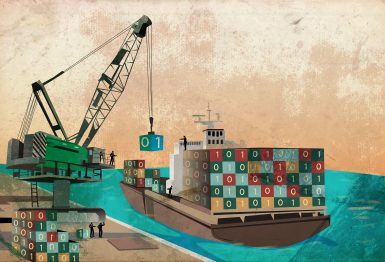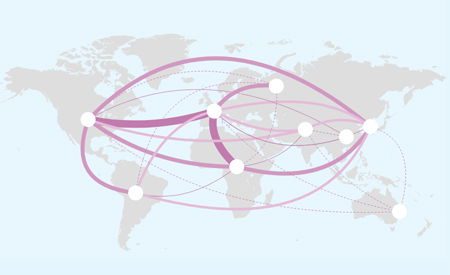The Changing Paradigm of Trade in the 21st Century
In his 1817 book On the Principles of Political Economy and Taxation, David Ricardo presented a streamlined view of the world that proved so useful and seductive that it is still at the heart of contemporary thinking about globalisation. Ricardo’s theory of comparative advantage predicts that nations specialise in producing and exporting the products that they are especially good at making.
20th-century globalisation reflected Ricardo’s framework, where trade was largely about selling goods to customers in one nation that were made in another nation. 21th-century globalisation also involves the unbundling of the production processes. As factories cross borders, intrafactory flows of goods, knowhow, investment, training, ideas and people become crucial elements of international commerce.
Since the early 1990s, rapidly falling communication and coordination costs have ended the need to perform most manufacturing stages within the same factory or industrial district, resulting in the internationalisation of production processes. This trend is reflected by the rise of offshoring, where companies move part of their production abroad.
This has de-nationalised comparative advantage, offering new paths towards industrial development. Instead of building the whole supply chain domestically to become competitive internationally (the 20th-century way), developing nations join international supply chains to become competitive and then industrialise by increasing their participation.
The new implications for development stem from the fact that 21th-century globalisation is really about know-how, not trade. This means that firms from high-technology nations combine their firm-specific managerial, technical and marketing know-how with low wages from developing nations.
The current state of global trade
 Shipping industry with loading binary code containers on ship representing the concept of software export, illustration.
Shipping industry with loading binary code containers on ship representing the concept of software export, illustration.However, globalisation has recently stopped accelerating. In 2016, for the first time in 15 years, global trade grew more slowly than GDP. Given the complexity of trade (which depends on a mix of demand and supply at work in different countries), the trade slowdown has been puzzling economists and a consensus has yet to be reached.
One side of the debate argues in favour of cyclical explanations. Trade can be slowed down by protectionism and deflated by depressed economies (exports and imports depend on demand). It may also depend on more benign factors, since the rapid growth of the 1990s and early 2000s was itself unnaturally high. Two forces added momentum to trade over that period: the revolution in information and communication technologies (ICTs) and China’s accession to the global economy.
A recent report by the International Monetary Fund tries to single out the factors at work (read here the report’s main conclusions). The analysis attributes most of the trade slowdown to the weak global demand. The shift away from trade-intensive consumption is a particular heave. Weak investment growth and the shift from advanced to emerging economies (advanced economies exhibit higher trade elasticities) are identified as the main channels.
Other evidence suggests that there is a structural change at work and global trade has reached a “new normal”. Research based on new data on demand, production and international trade attempts to unify both demand-side and production-side explanations for the trade slowdown. The data confirm that the fragmentation of production processes halted. This suggests that an upper limit has been reached in the growth of global supply chains, affecting countries’ ability to emulate the development strategy that has been used effectively for decades.
The fragmentation of international production might be reignited, since much potential is still unused. For instance, new low-wage nations may join global supply chains. However, the recent Brexit referendum and US presidential election suggest that tighter production links across borders are unlikely in the near future.
The future of globalisation
As argued in Richard Baldwin’s recent book The Great Convergence, globalisation is in for a radical new transformation, but this will only happen if the cost of moving people falls in the future as much as the cost of moving ideas has in the recent past.
Despite the benefits of 21st-century globalisation, salaries and wages are much higher in rich nations and there are billions of people who would like to earn those wages. They are, today, unable to do so since they find it hard to get into the rich nations. If technology opens a sluice gate that allows these people to offer their labour services in advanced economies without actually being there, the impact on jobs could be dramatic.
The relaxation of the face-to-face constraint may materialise via telepresence and telerobotics, as labour is made mobile by robots allowing people to offer their services remotely. In a nutshell, the next radical change in globalisation is likely to involve workers in one nation undertaking service tasks in another nation. Hotel rooms in Oslo could be cleaned by robots controlled by Philippine-based workers. Security guards in US shopping malls could be replaced by robots driven by someone sitting in Peru. The possibilities are only limited by the imagination.as labour is made mobile by robots allowing people to offer their services remotely
This is likely to produce two monumental changes. The first would stem from developed nation workers and managers applying their talents inside a wider range of developing nations without actually traveling to the nations. This would be a continuation of the unbundling and offshoring trend. The second set of changes would come from poor nation workers applying their talents inside rich nations without leaving home. As 21st-century globalisation has been disruptive for advanced countries’ manufacturing workers, the impact of telerobotics and telepresence is likely to be more revolutionary, since non-traded services would become tradable. The reader should bear in mind that only about 10%–15% of the population works directly in manufacturing in advanced nations; the rest work in services.
Globalization over five centuries (1500 – 2011)
Data sources: compilation of Klasing and Milionis (2014), Estavadeordal, Frantz and Taylor (2003) and the Penn World Tables Version 8.1
What is Globalisation?
Australia (2007–2010), as "the contraction of time and space in international transactions through the platform of new technologies". Globalization depends on (infra-)structure (roads, trains, shipping, flight routes, cables, ports), geo-climatic factors (global warming), technological innovations (digitalization; green energy, logistics, ITC) and, last but not least, a framework transnational norms. It rests on the twin logic of the acceleration and increase of the volume of exchanges of goods, capital, services, people and ideas, as well as the steady densification of geographic connectedness.
The IMF identifies four basic aspects of globalization: trade and transactions, capital and investment movements, migration and movement of people and the dissemination of knowledge. Further, environmental challenges such as climate change, cross-boundary water, air pollution, and over-fishing of the ocean are linked with globalization. Globalizing processes affect and are affected by business and work organization, economics, socio-cultural resources, and the natural environment.
Proponents of globalization argue that it allows poor countries and their citizens to develop economically and raise their standards of living, while opponents of globalization claim that the creation of an unfettered international free market has benefited multinational corporations in the Western world at the expense of local enterprises, local cultures, and common people. Resistance to globalization has therefore taken shape both at a popular and at a governmental level as people and governments try to manage the flow of capital, labor, goods, and ideas that constitute the current wave of globalization.
The Expanding Network of Global Flows
Source: McKinsey Global Institute

